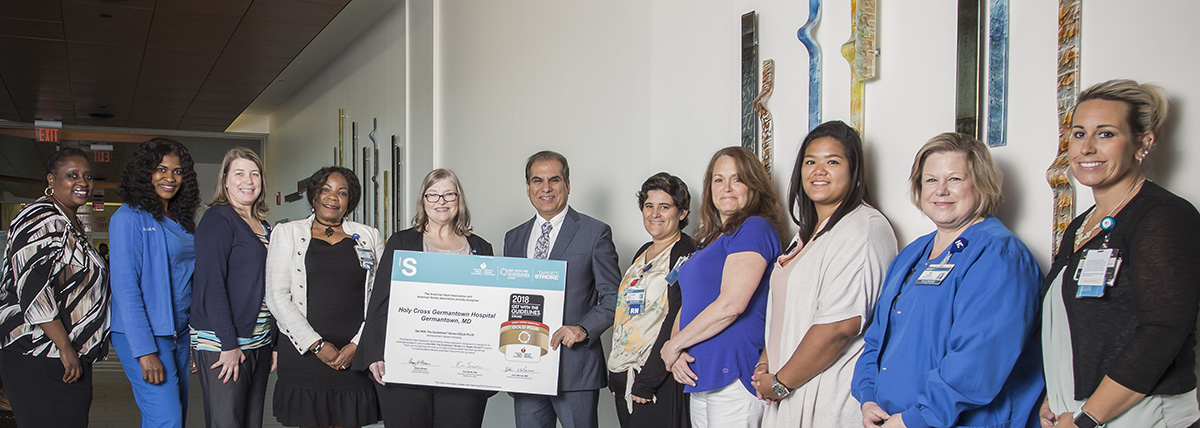Holy Cross Germantown Hospital Earns National and State Recognition for High Quality Stroke Care
July 10, 2018Tags: 2018
 Pictured are some key members of the Holy Cross Germantown Hospital Stroke Team
Pictured are some key members of the Holy Cross Germantown Hospital Stroke Team
Holy Cross Health is pleased to announce that Holy Cross Germantown Hospital has received the American Heart Association/American Stroke Association Gold Plus Quality Achievement Award, and was also designated a Primary Stroke Center by the Maryland Institute for Emergency Medical Service Systems (MIEMSS). This national and state recognition affirms the hospital's commitment to providing consistent high-quality stroke care that saves lives and improves outcomes for stroke patients.
According to the American Heart Association/American Stroke Association, stroke is the 5th leading cause of death and a leading cause of adult disability in the United States. On average, someone in the U.S. suffers a stroke every 40 seconds and nearly 795,000 people suffer a new or recurrent stroke each year.
"Holy Cross Germantown Hospital is committed to delivering high-quality, advanced stroke treatments to patients quickly and safely," said Doug Ryder, president, Holy Cross Germantown Hospital. "Achieving this recognition reflects the hard work and dedication of our specially-trained stroke team, who are available around the clock to provide the highest standard of care for stroke patients."
To earn the American Heart Association/American Stroke Association Gold Plus Award, Holy Cross Germantown Hospital had to meet specific quality achievement measures for the diagnosis and treatment of stroke patients at a set level for a designated period. These measures include evaluation of the proper use of medications and other stroke treatments aligned with the most up-to-date, evidence-based guidelines with the goal of speeding recovery and reducing death and disability for stroke patients.
Holy Cross Germantown Hospital additionally received the association’s Target: Stroke Honor Roll award. To qualify for this recognition, Holy Cross Germantown Hospital demonstrated that it meets quality measures developed to reduce the time between the patient’s arrival at the hospital and treatment with the clot-buster tissue plasminogen activator, or tPA, the only drug approved by the U.S. Food and Drug Administration to treat ischemic stroke. If given intravenously in the first three hours after the start of stroke symptoms, tPA has been shown to significantly reduce the effects of stroke and lessen the chance of permanent disability.
Holy Cross Germantown Hospital's designation as a MIEMSS Primary Stroke Center reflects the hospital's commitment and ability to meet the state of Maryland's regulations for the treatment of stroke patients. It means that statewide Emergency Medical Service (EMS) personnel can transport patients experiencing symptoms of stroke to the Holy Cross Germantown Hospital emergency department, where the journey of stroke care often begins.
"Our greatest reward is caring for our patients and helping them achieve the best possible outcome after a stroke," said Dr. Shahid Rafiq, medical director, Neurology and Stroke, Holy Cross Health. "The Holy Cross Germantown Hospital stroke team is dedicated to providing excellent stroke care by putting proven knowledge and guidelines to work on a daily basis."
To learn more about stroke care at Holy Cross Health visit HolyCrossHealth.org/Stroke.
Key members of the Holy Cross Germantown Hospital Stroke Team
Some key members of the Holy Cross Germantown Hospital Stroke Team (pictured above left - right) include: Sharon Harriston, RN, MS, CCNS, ACNP-BC, stroke nurse practitioner and coordinator, Stroke Program, Holy Cross Health; Lydia Opara, RN, nurse in-charge and stroke champion, Acute Care Unit; Julie Nenichka-Reed, MSN, MHA, RN, director, Neurosciences and Specialty Procedures, Holy Cross Health; Vivienne Bassey-McCoy, RN, nurse in-charge and stroke champion, Intensive Care Unit (ICU); Barbara Kline, MSN, RN, clinical education specialist/stroke center coordinator; Shahid Rafiq, MD, medical director, Neurology and Stroke, Holy Cross Health; Luciana Castro, RN, nurse in-charge and stroke champion, ICU; Dawn Limbaugh, nurse in-charge and stroke champion, Emergency Room; Anne Marie Dizon, laboratory manager; Kim Elliott, RN, chief nursing officer; Staci Smith, director, Radiology.
Recognizing the Signs of a Stroke
The best way to remember common stroke warning signs is to think of the acronym “BEFAST,” which was developed by Intermountain Healthcare.
*BEFAST stands for:
B = BALANCE: Has the person suddenly lost balance or coordination?
E = EYES: Has the person suddenly experienced changes in vision?
F = FACE: Does the person’s face look uneven, or does one side droop?
A = ARMS: Has one arm gone weak or numb?
S = SPEECH: Does the person’s speech sound slurred or strange?
T = TIME: If you observe any of these signs, it’s time to call 9-1-1 or get to the nearest stroke center or hospital emergency room for rapid diagnosis and treatment.
Other signs of stroke include numbness on one side of the body, trouble seeing with both eyes, trouble walking, and sudden onset of a severe headache.
*BEFAST was developed by Intermountain Healthcare, as an adaptation of the FAST model implemented by the American Stroke Association. Reproduced with permission from Intermountain Healthcare. Copyright 2011, Intermountain Health Care.
